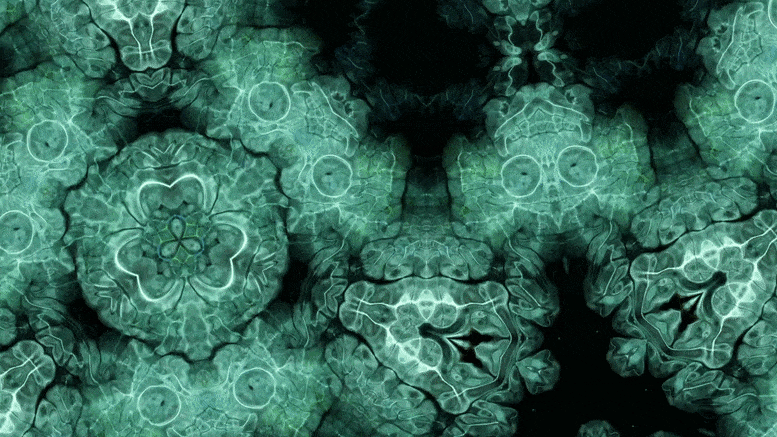
Scientists have developed a simple yet unconventional method called mechanochemistry to create unique layered materials with desirable electronic and magnetic properties.
Scientists at the U.S. Department of Energy’s Ames Laboratory and their collaborators from Iowa State University have developed a new approach for generating layered, difficult-to-combine, heterostructured solids. Heterostructured materials, composed of layers of dissimilar building blocks display unique electronic transport and magnetic properties that are governed by quantum interactions between their structurally different building blocks, and open new avenues for electronic and energy applications.
The technique for making them is simple, and counterintuitive—it involves smashing the pristine materials to build new ones. Called mechanochemistry, the technique uses ball milling to take apart structurally incommensurate solids— ones that don’t have matching atomic arrangements— and reassemble them into unique three dimensional (3D) “misfit” hetero assemblies. Smashing things together by milling seems like the least plausible way to achieve atomic ordering, but it’s turned out to be more successful than the scientists themselves imagined.
“A colleague of mine remarked that our ideas would be either naive or brilliant,” said Viktor Balema, Ames Laboratory Senior Scientist. “Some time ago we discovered stochastic reshuffling of layered metal dichalcogenides (TMDCs) into 3D hetero-assemblies during mechanical milling. It came as a complete surprise to us and triggered our curiosity about the possibility of atomic ordering through mechanochemical processing.”

Ames Laboratory’s technique for making heterostructured solids involves smashing the pristine materials to build new ones. Called mechanochemistry, the technique uses ball milling to take apart structurally incommensurate solids and reassemble them. Credit: U.S. Department of Energy, Ames Laboratory
Metal chalcogenides are often unique in their properties and uses. They can display remarkable electron transport behaviors ranging from complete lack of electrical conductivity to superconductivity, photo- and thermoelectric properties, mechanical pliability and, especially, the ability to form stable two-dimensional monolayers, three dimensional heterostructures, and other nano-scaled quantum materials.
“Nanostructures of misfit layered compounds (MLC) in the form of nanotubes, nanofilms (ferecrystals) and exfoliated sheets have been investigated for over a decade and offer a rich field of research and possibly also exciting applications in renewable energy, catalysis and optoelectronics, said Reshef Tenne of the Weizmann Institute of Science, Israel, and an expert in nanostructure synthesis. “One obstacle for their large-scale application is the high temperature and lengthy growth processes, which are prohibitive for large scale applications. The mechanochemical process developed by the Balema group at Ames Lab, besides being stimulating scientifically, brings us one step closer to realize down-to-earth applications for these intriguing materials.”
Typically, these complex materials, especially ones with the most unusual structures and properties, are made using two different synthetic approaches. The first, known as top-down synthesis, employs two-dimensional (2D) building blocks to assemble them, using additive manufacturing techniques. The second approach, broadly defined as bottom-up synthesis, uses stepwise chemical reactions involving pure elements or small molecules that deposit individual monolayers on top of each other. Both are painstaking and have other disadvantages such as poor scalability for use in real-world applications.
The Ames Laboratory team combined these two methods into one mechanochemical process that simultaneously exfoliates, disintegrates and recombines starting materials into new heterostructures even though their crystal structures do not fit each other well (i.e. misfit). Theoretical (DFT) calculations, supported by the results of X-ray diffraction, scanning transmission electron microscopy, Raman spectroscopy, electron transport studies and, for the first time ever, solid state nuclear magnetic resonance (NMR) experiments, explained the mechanism of the reorganization of precursor materials and the driving forces behind the formation of novel 3D heterostructures during mechanical processing.
“Solid-state NMR spectroscopy is an ideal technique for the characterization of powdered materials that are obtained from mechanochemistry,” said Aaron Rossini, Ames Laboratory scientist and professor of chemistry at Iowa State University. “By combining information obtained from solid-state NMR spectroscopy with other characterization techniques we are able to obtain a complete picture of the 3D heterostructures.”
Reference: “Unprecedented generation of 3D-heterostructures by mechanochemical disassembly and re-ordering of incommensurate metal chalcogenides” by Oleksandr Dolotko, Ihor Z. Hlova, Arjun K. Pathak, Yaroslav Mudryk, Vitalij K. Pecharsky, Prashant Singh, Duane D. Johnson, Brett W. Boote, Jingzhe Li, Emily A. Smith, Scott L. Carnahan, Aaron J. Rossini, Lin Zhou, Ely M. Eastman and Viktor P. Balema, 12 June 2020, Nature Communications.
DOI: 10.1038/s41467-020-16672-0
The experimental synthesis work was performed under the auspices of the 2019 laboratory-directed research and development (LDRD) program at Ames Laboratory. Theory support, solid-state NMR spectroscopy, structural and physical property characterization efforts were funded by the U.S. Department of Energy (DOE) Office of Science.
Ames Laboratory is a U.S. Department of Energy Office of Science national laboratory operated by Iowa State University. Ames Laboratory creates innovative materials, technologies, and energy solutions. We use our expertise, unique capabilities, and interdisciplinary collaborations to solve global problems.
DOE’s Office of Science is the single largest supporter of basic research in the physical sciences in the United States, and is working to address some of the most pressing challenges of our time.

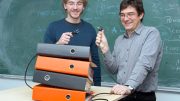
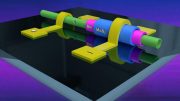
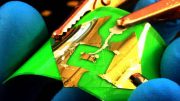
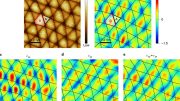

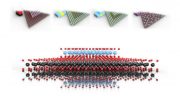
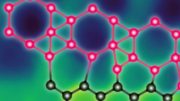
Be the first to comment on "Using Chaos as a Tool: Scientists Discover New Method of Making 3D-Heterostructures"